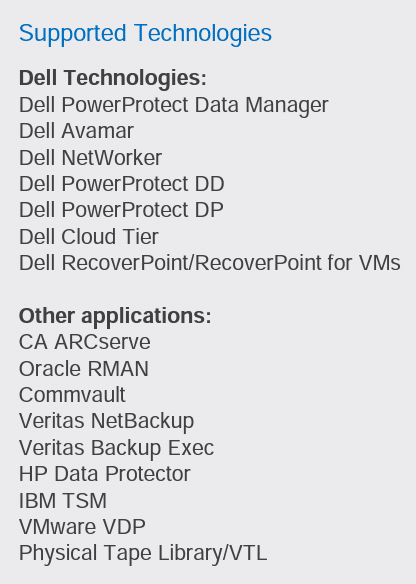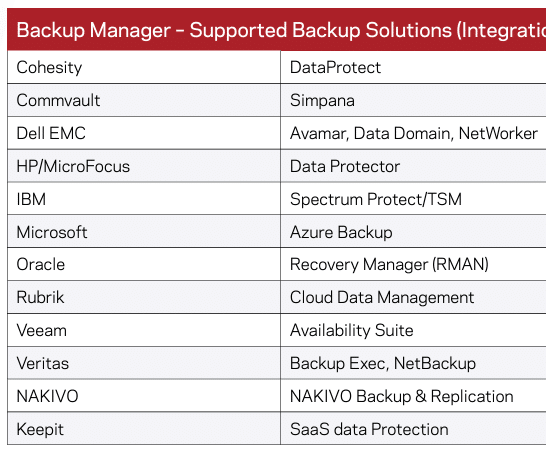In Part 1 of this series, we looked at how leading enterprise data protection providers are pushing for tech stack consolidation against a backdrop of persistently heterogeneous enterprise backup environments. In Part 2, we will explore how this mismatch between supply side ambitions and demand side realities has affected the enterprise data protection monitoring market.
Leading enterprise data protection software providers do recognize the value of backup monitoring. Many (like Dell, Veritas, and Veeam) offer a backup monitoring product when selling you their core backup products.
However, data protection vendors have a different set of motives for offering backup monitoring compared to pureplay monitoring providers like Bocada.
Let us explore some of the key differences and what they mean for enterprise customers.
Siloed and fragmented monitoring
Consider the following three data protection monitoring tools, which are each offered by a different enterprise data protection software provider:
- Data Protection Advisor / DPA (Dell)
- NetBackup IT Analytics (Veritas, formerly Aptare)
- Veeam One (Veeam)
The more commercial monitoring options in the market, the better, right? What is the problem?
The root cause of several problems we will be looking at is that these companies see backup monitoring as a secondary interest – one they will gladly pursue – but only if doing so helps them with their primary goals: adoption and growth of their flagship backup products.
One obvious outcome of a secondary interest in monitoring is that these vendor-provided backup monitoring tools favor their own backup products and/or lack support for many popular backup products and environments, resulting in siloed and fragmented monitoring.
For example, here are all the backup applications DPA supports:
It is readily apparent that DPA is focused on Dell backup products (alongside a few mostly legacy third-party products). While the bias for Dell products is understandable given their primary goal (to sell their own products), it inevitably leads to vendor lock-in, which is great for vendors but dangerous for customers.
Here is what NetBackup IT Analytics supports:
The support here is more diversified than DPA’s (partly because Veritas has fewer backup products of its own), however the overall coverage is still thin. Popular products from the likes of Druva, Acronis, and HYCU are not supported, and you can see gaps in support for AWS (Amazon Web Services) and Google Cloud backups (though Azure Backup is listed).
Also, in case you would like some anecdotal evidence that Veritas’ goal with IT Analytics is to acquire/retain more Veritas NetBackup customers, consider that the product was recently renamed “NetBackup IT Analytics” (from Aptare IT Analytics).
Finally, let us look at what Veeam One supports:
In terms of supported backup products, Veeam One only supports Veeam B&R and Veeam Backup for M365. Note: This seemingly narrow scope could actually be quite sensible for Veeam One, given that Veeam has successfully gotten many smaller (non-enterprise) organizations to consolidate onto Veeam tools.
Loss-leader strategies = hidden costs
In many countries, mobile/wireless providers effectively dangle free smartphone offers to lure in new sign-ups. From a rational standpoint, the choice to switch carriers should hinge on service quality and overall cost, rather than the allure of a complimentary phone. However, this promotional tactic undeniably succeeds in directing customers’ attention toward immediate savings, causing them to overlook the overall costs.
In enterprise data protection, vendors sometimes employ similar loss-leader strategies with their monitoring products.
Specifically, a data protection vendor will bundle their monitoring product with their backup products or sell for low/no cost, increasing the perceived value of the overall data protection solution while shifting costs to later stages of the customer lifecycle.
When a customer goes for a backup provider’s low/no-cost monitoring solution, they often later pay the difference (and then some) through some combination of the following:
- Professional Services – Many legacy/house-brand monitoring tools are under resourced (often because the resources go to higher-priority products). Therefore, it is common for such tools to lack self-service configurability and/or perform poorly due to excessive technical debt.
-
- To work around these limitations in the under-resourced or under-maintained product, the provider will charge its customers for expensive “pro services” – for everything from fixing data collection issues to customizing reports.
- Because the lack of investment into the product is intentional, strategic, and ongoing, the stream of professional services fees never ends.
- Renewals – Once you have locked into their products and their siloed monitoring solution and invested heavily into customizations/enhancements (via pro services), you will experience a high degree of vendor lock-in. Come renewal time, this can result in an inability to switch to other vendors and/or to negotiate favorable pricing and other terms.
Stagnant development is a serious risk
So, vendor-provided legacy monitoring tools are often not seen as high priorities by their providers, resulting in siloed monitoring and a stream of hidden costs.
Another key consideration is the effect stagnant development can have on a customer’s data protection and security posture.
Modern threats like ransomware and paradigm shifts like multi-cloud computing and GenAI require timely action to close data protection gaps and keep tools relevant.
When a legacy monitoring tool is under-resourced or under-prioritized, common outcomes include:
- Poor customer responsiveness (e.g., feature requests are ignored)
- Longer development cycles (e.g., excessive and risky delays before changes are made)
- Lack of innovation (I.e., sparse roadmap)
Any of these outcomes can lead to catastrophic data loss incidents down the road.
Here are a few signs that your monitoring product is stagnant:
- It only gets updated a few times per year (I.e., three or fewer releases)
- Product releases primarily contain bug fixes and compatibility-focused enhancements (few features)
- Feature requests are rarely acted upon or take unreasonably long to implement
- There is a persistent lack of support for cloud and/or modern backup products
Note: In some cases, these symptoms precede a formal announcement that a product will be facing its imminent End of Life (EOL), requiring customers to migrate to an alternative solution.
The key thing to remember with regard to stagnancy is that it isn’t just an inconvenience; it’s a major risk to an organization’s data protection and overall security posture.
Spot the differences
We have explored some challenges with vendor-provided or legacy backup monitoring software that your data protection team must consider when building a resilient monitoring framework.
Here is a quick summary to highlight (1) what to watch out for, and (2), how Bocada’s category-leading enterprise monitoring product is different.
Vendor-Provided or Legacy Backup Monitoring Software:
⛔️ Data protection monitoring is secondary to other interests (like selling backup software)
⛔️ Only a handful of supported backup products, with a strong bias towards their own products, leading to vendor lock-in and siloed tooling
⛔️ Little/no active innovation, sporadic releases (e.g., 1-3 per year), leading to poor data protection and security risks
⛔️ Low/no upfront software costs but an endless barrage of professional services fees (e.g., to create custom reports and troubleshoot data collection issues)
Bocada:
✅ Data protection monitoring & automation focus
✅ API-based connectors for 40+ backup & storage products (cloud, on-prem, modern & legacy)
✅ 70+ report templates with powerful self-service customization (no pro services fees)
✅ Monthly releases featuring innovative new capabilities, connectors, and enhancements
This concludes our two-part analysis of recent data protection software trends (Part One) and the data protection monitoring landscape. If you are considering or evaluating backup monitoring software for your enterprise, we encourage you to get in touch with our solutions experts to experience the Bocada difference.



